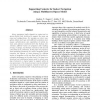Free Online Productivity Tools
i2Speak
i2Symbol
i2OCR
iTex2Img
iWeb2Print
iWeb2Shot
i2Type
iPdf2Split
iPdf2Merge
i2Bopomofo
i2Arabic
i2Style
i2Image
i2PDF
iLatex2Rtf
Sci2ools
MDM
2009
Springer
2009
Springer
Supporting Contexts for Indoor Navigation Using a Multilayered Space Model
Indoor navigation highly depends on context and requires flexible data structures to support the many use cases and configurations. For example, an indoor navigation system must cope with different localisation techniques, infrastructures, and capabilities of mobile devices. Also physical constraints from the built-up environment, different modes of navigation (like walking, driving, or flying), and thematic restrictions like security zones have to be considered. In this paper we propose a novel modelling framework for indoor navigation which considers the aspects of route planning for different modes of navigation on the one hand and of various localisation techniques on the other hand. It is based on a structured and multilayered space model in which every type of physical or logical aspect is mapped within its own space layer. It is shown how layers can be combined according to concrete navigation contexts to build an npartite graph facilitating both route planning and localisation...
| Added | 27 May 2010 |
| Updated | 27 May 2010 |
| Type | Conference |
| Year | 2009 |
| Where | MDM |
| Authors | Thomas Becker, Claus Nagel, Thomas H. Kolbe |
Comments (0)

